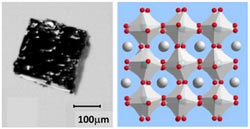Development of “Slater Insulator” that Rapidly Changes from Conductor to Insulator at Room Temperature

(Left) Photograph of a crystal of Perovskite type osmium oxide and (right) schematic diagram of its crystal structure. White circles: sodium ions, red circles: oxygen ions. Osmium ions exist in the central part of the octahedron. ©NIMS<br>
Dr. Kazunari Yamaura, a Principal Researcher of the Strongly Correlated Materials Group, Superconducting Properties Unit, National Institute for Materials Science (NIMS; President: Sukekatsu Ushioda), in joint work with a research group at the Oak Ridge National Laboratory in the United States, succeeded in development of a Slater insulator which functions at room temperature.
Slater insulators have been studied for more than 50 years as insulators with special properties. Although Slater insulators display the properties of metals at a sufficiently high temperature, they become insulators when cooled to a certain temperature (transition temperature) peculiar to the substance concerned. Because this transition temperature was conventionally far lower than room temperature, study had been limited to scientific research, and virtually no research had been done aiming at development to applications.
This research clarified the fact that a new material (Perovskite type osmium oxide), which was synthesized for the first time by NIMS in 2009, is the Slater insulator with the highest transition temperature to date. This result was verified through joint experimental research with a research group at the Oak Ridge National Laboratory in the United States using the neutron diffraction method.
Because this new material displays the characteristics of a Slater insulator at room temperature without requiring cooling, it is not only scientifically interesting, but also has the potential for development to application as a new material. If further progress can be achieved in research with this new material as a starting point, there is a possibility that new materials and devices with unprecedented functions can be developed. Concretely, application to solid state devices for detecting signals in the terahertz region, new thermoelectric conversion materials, etc. is considered possible. In the future, research will be carried out aiming at development of new materials with possible practical applications.
This result was obtained as part of “Research on Energy Conversion Functions of Slater Materials” (Research representative: Kazunari Yamaura) under the Advanced Low Carbon Technology Research and Development Program (ALCA) of the Japan Science and Technology Agency (JST). This achievement is to be published in a journal of the American Physical Society, Physical Review Letters (online version).
For further details:
Principal Researcher, Superconducting Properties Unit
Kazunari Yamaura
TEL: +81-29-860-4658
FAX: +81-29-860-4674
E-Mail: YAMAURA.Kazunari=nims.go.jp
(Please change “=” to “@”)
For general information:
NIMS Public Relations Office
TEL: +81-29-859-2026
FAX: +81-29-859-2017
E-Mail: pr@nims.go.jp
Media Contact
More Information:
http://www.nims.go.jpAll latest news from the category: Materials Sciences
Materials management deals with the research, development, manufacturing and processing of raw and industrial materials. Key aspects here are biological and medical issues, which play an increasingly important role in this field.
innovations-report offers in-depth articles related to the development and application of materials and the structure and properties of new materials.
Newest articles

Properties of new materials for microchips
… can now be measured well. Reseachers of Delft University of Technology demonstrated measuring performance properties of ultrathin silicon membranes. Making ever smaller and more powerful chips requires new ultrathin…

Floating solar’s potential
… to support sustainable development by addressing climate, water, and energy goals holistically. A new study published this week in Nature Energy raises the potential for floating solar photovoltaics (FPV)…

Skyrmions move at record speeds
… a step towards the computing of the future. An international research team led by scientists from the CNRS1 has discovered that the magnetic nanobubbles2 known as skyrmions can be…





















